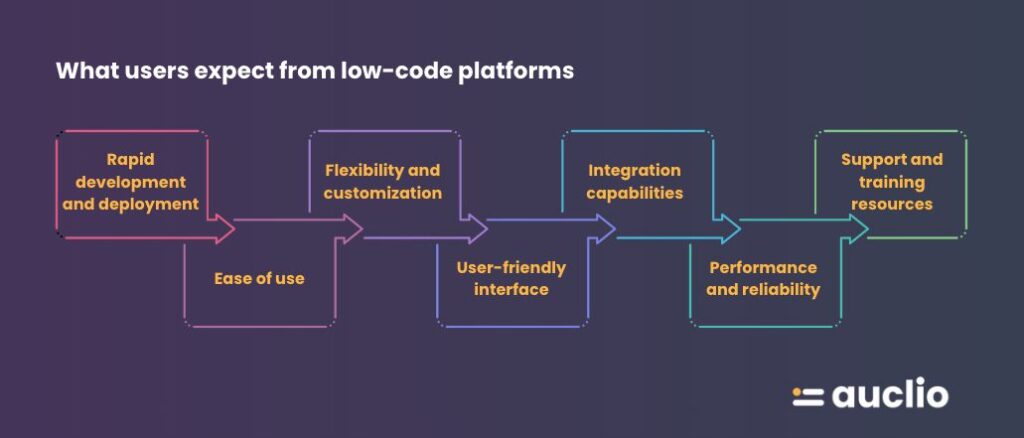
Feedback insights: What users expect from low-code platforms
By analyzing user reviews and ratings from Gartner Peer Reviews and G2 for the most popular low-code platforms, we’ve identified what low-code platform features users truly need and expect. From the features they love to the concerns they raise, this analysis provides insights into what makes a low-code platform great. Let’s dive into these findings to understand what users are really looking for.
What features make a great low-code platform?
Rapid development and deployment
One of the biggest advantages users mention is the speed of development. Low-code platforms allow them to build and launch applications much faster than traditional coding methods. This enables teams to test ideas and get their solutions to market faster.
Ease of use
Users appreciate how easy low-code platforms are to use. It enables people with little or no coding experience to create applications, allowing more team members to contribute to building solutions.
Flexibility and customization
Thanks to low-code platforms, users can create anything from simple forms to complex, multi-layered applications. Businesses can customize apps to fit their specific needs. They don’t have to use generic, one-size-fits-all solutions. Instead, they can create tools that match their exact workflows and goals.
User-friendly interface, customization and modern design
Users want a simple, easy-to-use interface with a familiar layout. They see drag-and-drop features as essential because it lets them build apps without writing code. They also want the ability to tweak the look and feel of the apps they build, such as adding their logo and company colors. Modern, responsive design and options like dark mode are also highly valued.
Integration capabilities
Integration is another big plus. Users value low-code platforms that easily connect with other tools and systems they already use, such as CRMs, databases and ERP systems. Good integration options reduce the need for complex workarounds.
Performance and reliability
Users expect low-code platforms to handle heavy workloads without slowing down. Fast, reliable performance is key, especially when working with large datasets. User experience is highly affected if a platform can’t keep up.
Support and training resources
Having access to good support and training resources is a big factor for users. Many platforms offer tutorials, certification programs, and active user communities. These resources help users learn the platform and solve problems internally.

Deploying low-code: Common challenges
While there are many positive sides, users also have concerns about low-code platforms. Here are the most common ones.
- Pricing concerns: Some users feel that low-code platforms can be expensive, especially as their needs grow. Costs can rise with more advanced features or higher usage levels. However, the time saved and reduced development costs balance this out, making low-code development significantly more affordable than traditional methods.
- Performance and scalability issues: A common worry is whether the platform will deliver performance and scale as the business grows. Yet, many platforms optimize performance and improve scalability options to handle data-heavy applications.
- Documentation and support limitations: Although such platforms are easy to use, some users find the documentation lacking when it comes to advanced features. Still, most platforms offer helpful support and resources to fill in the gaps.
- Complexity: Low-code is designed to simplify development. Yet, advanced features can be tricky. If the platform becomes too complex, it can neutralize the benefits of using a low-code approach. Still, the ease of use for basic tasks and detailed documentation and support for conducting complex ones is what draws many users to such solutions.
- UI/UX dislikes: Some users criticize the look and feel of certain platforms that are outdated or cluttered. Even though there are customization options, they often don’t go far enough for users who need very specific designs. However, the ability to quickly prototype and customize designs is still a big plus for many.
Conclusion
Understanding what users love and what they worry about in low-code platforms provides valuable insights for improving these tools. Users want speed, ease of use, flexibility, good integration, and strong performance. On the flip side, potential high costs and complexity, limited scalability and design, inadequate documentation and support are pain points to be addressed. Meeting these concerns can help make a low-code platform truly great.
Auclio
At Auclio, our low-code platform is built with users’ expectations of low-code platforms in mind, ensuring a balance of speed, usability, flexibility and support.
Explore Auclio platform today by learning how it works, reading answers to some more frequently asked questions, or get started to experience the difference for your business firsthand.



